Biology
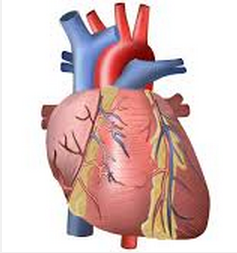 1 The human heart, like that of all mammals, has two atria and two ventricles. Blood enters the heart by the atria and leaves from the ventricles. A septum separates the right side of the heart, which contains deoxygenated blood, from the left side, which contains oxygenated blood.
1 The human heart, like that of all mammals, has two atria and two ventricles. Blood enters the heart by the atria and leaves from the ventricles. A septum separates the right side of the heart, which contains deoxygenated blood, from the left side, which contains oxygenated blood.
2 Semilunar valves at the entrances to the blood vessels that leave the heart (aorta and pulmonary
artery) prevent back flow of blood into the heart, and atrioventricular valves prevent backflow of blood from ventricles into the atria.
3 The heart is made of cardiac muscle and is myogenic (the muscle is self-stimulating).
4 The sinoatrial node (SAN) sets the pace of contraction for the muscle in the heart. Excitation
waves spread from the SAN across the atria, causing their walls to contract. A non-conducting barrier prevents these excitation waves from spreading directly into the ventricles, thus delaying their
contraction. Th e excitation wave travels to the ventricles via the atrioventricular node (AVN) and
the Purkyne tissue, which runs down through the septum, before spreading out into the walls of the
ventricles.
5 Both sides of the heart contract and relax at the same time. Th e contraction phase is called systole, and the relaxation phase is diastole. One complete cycle of contraction and relaxation is known as the cardiac cycle.
1. Multiple-choice test
1 Which of the following describes the mammalian circulation?
A open single circulation
B closed single circulation
C open double circulation
D closed double circulation
2 The diagram shows a vertical section through a human heart.

3 Which row describes the aorta?
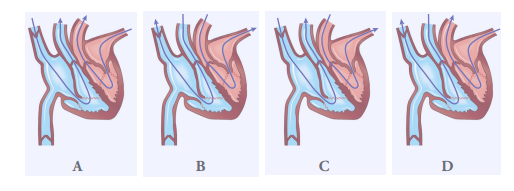
4 The diagrams are vertical sections through the human heart.
Which pair of arrows shows blood flow through the heart?

5 The right ventricle has much less muscle in its wall than the left ventricle.
What are the consequences of this?
1 The right ventricle develops a much smaller pressure than the left ventricle.
2 The right ventricle delivers a smaller volume of blood than the left ventricle.
3 Blood from the right ventricle travels less far than blood from the left ventricle.
A 1, 2 and 3
B 1 and 2 only
C 1 and 3 only
D 2 and 3 only
6 What are the positions of the valves on the left side of the heart when the pressure in the left ventricle is higher than the pressures in the left atrium and aorta?
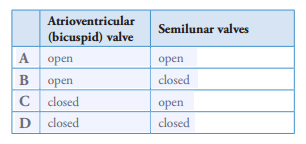 7 Which of the following statements is not correct?
7 Which of the following statements is not correct?
A Atrial muscles are connected to the ventricle muscles, except at the atrioventricular node (AVN).
B Both atria contract at the same time.
C Both ventricles contract at the same time.
D Contraction of the atria is complete before contraction of the ventricles begins.
8 Which is the correct sequence of events in a cardiac cycle, beginning with its initiation by the pacemaker?
1 A wave of electrical activity passes along Purkyne tissue.
2 A wave of electrical activity reaches the atrioventricular node (AVN).
3 A wave of electrical activity spreads from the sinoatrial node (SAN) across the atria.
4 Cardiac muscle of the walls of the atria contracts.
5 Cardiac muscle of the walls of the ventricles contracts.
A 1 ? 5 ? 3 ? 4 ? 2
B 2 ? 1 ? 5 ? 3 ? 4
C 3 ? 4 ? 2 ? 1 ? 5
D 4 ? 2 ? 1 ? 5 ? 3
9 When a heart is removed from a mammal and kept in well-oxygenated buffer solution at 37°C, it continues to beat rhythmically.
What may be concluded about the heart from this observation?
A It has an in-built mechanism for initiating contractions.
B It needs a blood supply to be able to contract.
C It needs a stimulus from a nerve to be able to contract.
D It needs a stimulus from a hormone to be able to contract.
10 The volume of blood pumped by the heart in a given period of time is called the cardiac output. It is calculated from the volume of blood pumped by one contraction of the heart (stroke volume) and the number of times the heart contracts per minute (heart rate).
cardiac output = stroke volume × heart rate
The cardiac output of a heart beating at 75 beats per minute was calculated to be 6.0dm3 per minute.
What was the stroke volume of the heart?
A 0.08cm3
B 12.5cm3
C 80cm3
D 125cm3
2. End-of-chapter questions
1 Where is the mammalian heart beat initiated?
A atrioventricular node
B left atrium
C Purkyne tissue
D sinoatrial node
2 What causes the bicuspid valve to close during ventricular systole?
A a greater blood pressure in the left atrium than in the left ventricle
B a greater blood pressure in the left ventricle than in the left atrium
C contraction of muscles in the septum
D contraction of muscles in the valve
3 Figure below shows the pressure changes in the left atrium, left ventricle and aorta throughout two cardiac cycles. Make a copy of this diagram.
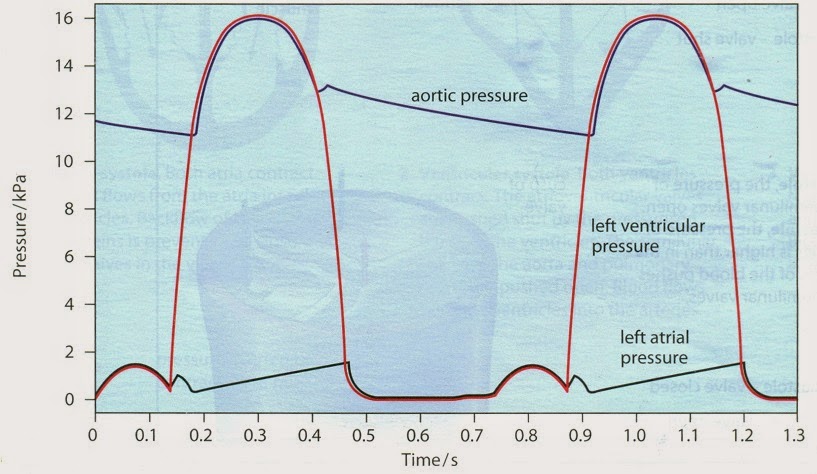
a i How long does one heart beat (one cardiac cycle) last?
ii What is the heart rate represented on this graph, in beats per minute?
b The contraction of muscles in the ventricle wall causes the pressure inside the ventricle to rise. When the muscles relax, the pressure drops again. On your copy of the diagram, mark the following periods:
i the time when the ventricle is contracting (ventricular systole)
ii the time when the ventricle is relaxing (ventricular diastole).
c The contraction of muscles in the wall of the atrium raises the pressure inside it. This pressure is also raised when blood flows into the atrium from the veins, while the atrial walls are relaxed. On your copy of the diagram, mark the following periods:
i the time when the atrium is contracting (atrial systole)
ii the time when the atrium is relaxing (atrial diastole).
d The atrioventricular valves open when the pressure of the blood in the atria is greater than that in the ventricles. They snap shut when the pressure of the blood in the ventricles is greater than that in the atria. On your diagram,mark the point at which these valves will open and close.
e The opening and closing of the semilunar valves in the aorta depends in a similar way on the relative pressures inthe aorta and ventricles. On your diagram, mark the point at which these valves will open and close.
f The right ventricle has much less muscle in its walls than the left ventricle, and only develops about one-quarter of the pressure developed on the left side of the heart. On your diagram, draw a line to represent the probablepressure inside the right ventricle over the 1.3 seconds shown.
The diagram shows a normal ECG. The paper on which the ECG was recorded was running at a speed of 25 mm s-1
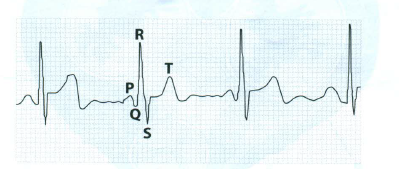
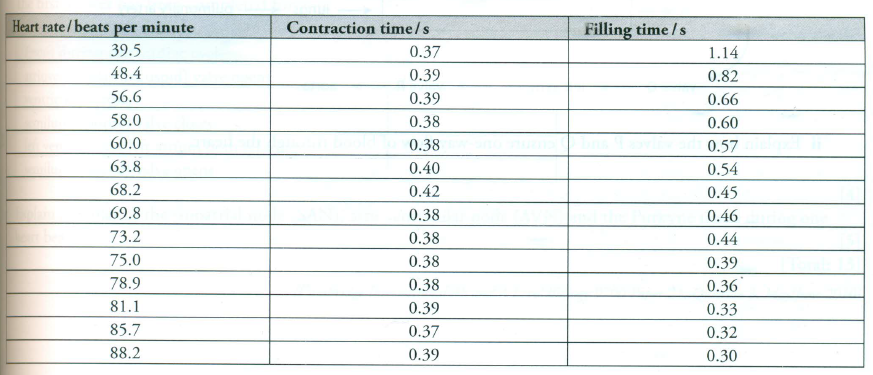
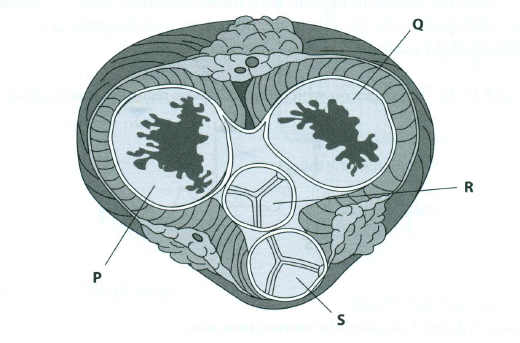 a i Copy and complete the following flow chart to show the pathway of blood through the heart.
a i Copy and complete the following flow chart to show the pathway of blood through the heart.

ii Explain how the valves P and Q ensure one-way flow of blood through the heart.
The cardiac cycle describes the events that occur during one heart beat. The following figure shows the changes in pressure that occur within the left atrium, left ventricle and aorta during one heart beat.
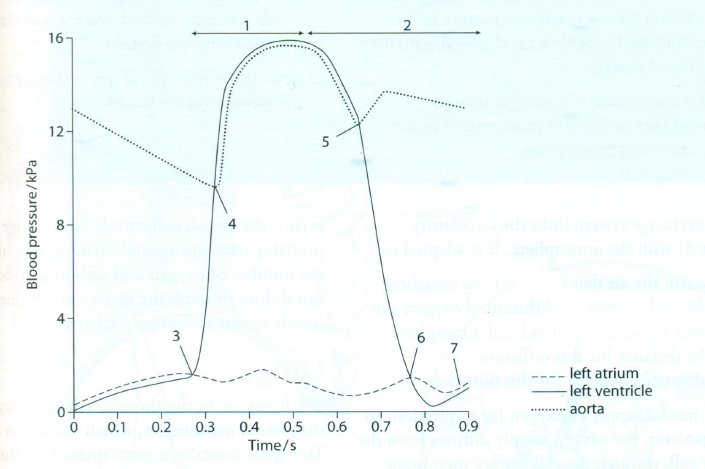 Copy and complete the table below. Match up each event during the cardiac cycle with an appropriate number from 1 to 7 on the figure. You should put only one number in each box. You may use each number once, more than once or not at all.
Copy and complete the table below. Match up each event during the cardiac cycle with an appropriate number from 1 to 7 on the figure. You should put only one number in each box. You may use each number once, more than once or not at all.
The firstanswer has been completed for you.

[Total: 13]
[Cambridge Intemational AS andA Level Biology 9700 Paper 21, Question 3, May - june 2010]
3. End-of-chapter answers
1 D
2 B
3 a i about 0.75 seconds
ii 60 ÷ 0.75 = 80 beats per minute
For b, c, d, e and f, see figure below.
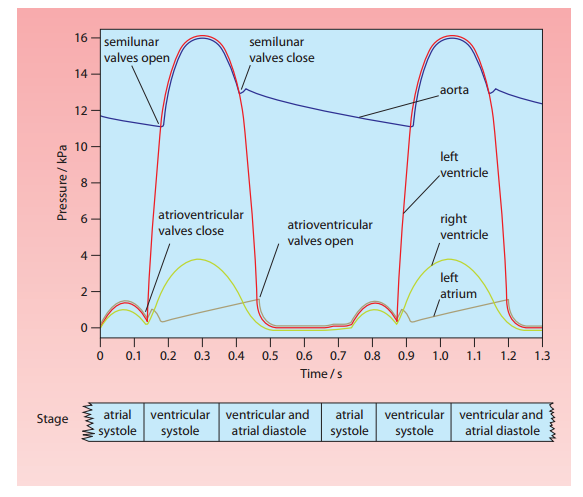
4 a 1 beat = about 20 mm on the grid. 25 mm on the grid represents 1 second
so 20 mm represents 20÷25 seconds = 0.8 seconds. If one beat lasts 0.8 seconds, then in 1 second there are 1÷0.8 beats so in 1 minute there are 60÷0.8 = 75 beats.
b i this is the time during which the ventricles are contracting
ii on the grid, the distance between Q and T is about 7 mm this represents 7 ÷ 25 = 0.28 seconds
c i this is the time when the ventricles are relaxed, and are fi lling with blood
ii on the grid, the distance between T and Q is about 13 mm
this represents 13 ÷ 25 = 0.52 seconds
A quicker way of working this out is to subtract the answer to b ii from 0.8 seconds.
d i by performing varying levels of exercise
ii
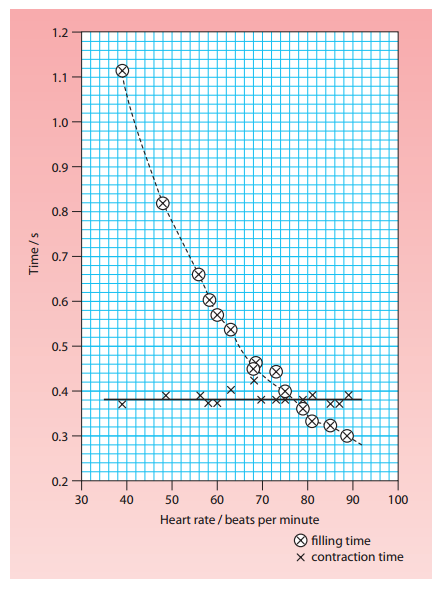
iii As heart rate increases, contraction time remains constant, but fi lling time decreases.
This indicates that the increase in heart rate is produced by a shorter time interval between
ventricular contractions, rather than by a faster ventricular contraction.
The more frequent contractions increase the rate of circulation of blood around the body,
providing extra oxygen to exercising muscles.
If this was done by shortening the time over which the ventricles contract, much of the
advantage would be lost, as less blood would probably be forced out by each contraction.
By shortening the time between contractions, the amount of blood pumped out of the heart
per unit time is increased.
Exam-style questions
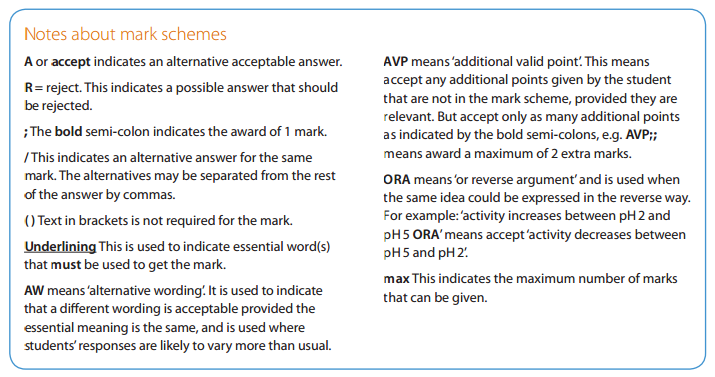
5 a i right ventricle;
pulmonary vein; [2]
ii they open to allow blood to fl ow from atria to ventricles;
they close during ventricular systole/when ventricles contract;
reference to closure being caused by diff erences in pressure in atria and ventricles; [max. 2]
c SAN produces rhythmic pulses of electrical activity;
which spread across the muscle in the atria;
causes muscle in atria to contract;
specialised tissue, in septum/near AVN, slows spread/delays transfer to ventricles;
Purkyne tissue conducts impulses down through septum;
impulses spread upwards through ventricle walls;
causing ventricles to contract from bottom upwards;
delay of 0.1 to 0.2 s after atrial walls; [max. 5]
- #83 Question 6
The diagram below shows pressure changes in the left atrium and left ventricle of the heart and the aorta during the cardiac cycle. (a) Calculate how many heart beats there will be in one minute. (2 marks)(b) (i) On the diagram, indicate the point at...
- # 44 The Circulatory System - Blood Vessels
The mammalian circulatory system is a closed double circulation, consisting of a heart, blood vessels and blood. The heart produces high pressure --> blood moves through the vessels by mass flow. The mammalian...
- #43.2 Transport In Mammals - Syllabus 2016
8.1 The circulatory system 8.2 The heart As animals become larger, more complex and more active, transport systems become essential to supply nutrients to, and remove waste from, individual cells. Mammals...
- #43.1 Transport In Mammals - Syllabus 2015
? The need for, and functioning of, a transport system in mammals ? Structure and functioning of the mammalian heart Learning Outcomes Candidates should be able to: (m) [PA] describe the structures of arteries, veins and capillaries and be able to...
- Body Fluids And Circulation
Click here for PDFCirculation is the transport of nutrients, oxygen, CO2 and excretory products to the concerned tissues or organs.For circulation, simple organisms (sponges, coelenterates etc) use water from their surroundings....
Biology
#48 Summary of The mammalian heart

2 Semilunar valves at the entrances to the blood vessels that leave the heart (aorta and pulmonary
artery) prevent back flow of blood into the heart, and atrioventricular valves prevent backflow of blood from ventricles into the atria.
3 The heart is made of cardiac muscle and is myogenic (the muscle is self-stimulating).
4 The sinoatrial node (SAN) sets the pace of contraction for the muscle in the heart. Excitation
waves spread from the SAN across the atria, causing their walls to contract. A non-conducting barrier prevents these excitation waves from spreading directly into the ventricles, thus delaying their
contraction. Th e excitation wave travels to the ventricles via the atrioventricular node (AVN) and
the Purkyne tissue, which runs down through the septum, before spreading out into the walls of the
ventricles.
5 Both sides of the heart contract and relax at the same time. Th e contraction phase is called systole, and the relaxation phase is diastole. One complete cycle of contraction and relaxation is known as the cardiac cycle.
1. Multiple-choice test
1 Which of the following describes the mammalian circulation?
A open single circulation
B closed single circulation
C open double circulation
D closed double circulation
2 The diagram shows a vertical section through a human heart.

3 Which row describes the aorta?

4 The diagrams are vertical sections through the human heart.
Which pair of arrows shows blood flow through the heart?

5 The right ventricle has much less muscle in its wall than the left ventricle.
What are the consequences of this?
1 The right ventricle develops a much smaller pressure than the left ventricle.
2 The right ventricle delivers a smaller volume of blood than the left ventricle.
3 Blood from the right ventricle travels less far than blood from the left ventricle.
A 1, 2 and 3
B 1 and 2 only
C 1 and 3 only
D 2 and 3 only
6 What are the positions of the valves on the left side of the heart when the pressure in the left ventricle is higher than the pressures in the left atrium and aorta?

A Atrial muscles are connected to the ventricle muscles, except at the atrioventricular node (AVN).
B Both atria contract at the same time.
C Both ventricles contract at the same time.
D Contraction of the atria is complete before contraction of the ventricles begins.
8 Which is the correct sequence of events in a cardiac cycle, beginning with its initiation by the pacemaker?
1 A wave of electrical activity passes along Purkyne tissue.
2 A wave of electrical activity reaches the atrioventricular node (AVN).
3 A wave of electrical activity spreads from the sinoatrial node (SAN) across the atria.
4 Cardiac muscle of the walls of the atria contracts.
5 Cardiac muscle of the walls of the ventricles contracts.
A 1 ? 5 ? 3 ? 4 ? 2
B 2 ? 1 ? 5 ? 3 ? 4
C 3 ? 4 ? 2 ? 1 ? 5
D 4 ? 2 ? 1 ? 5 ? 3
9 When a heart is removed from a mammal and kept in well-oxygenated buffer solution at 37°C, it continues to beat rhythmically.
What may be concluded about the heart from this observation?
A It has an in-built mechanism for initiating contractions.
B It needs a blood supply to be able to contract.
C It needs a stimulus from a nerve to be able to contract.
D It needs a stimulus from a hormone to be able to contract.
10 The volume of blood pumped by the heart in a given period of time is called the cardiac output. It is calculated from the volume of blood pumped by one contraction of the heart (stroke volume) and the number of times the heart contracts per minute (heart rate).
cardiac output = stroke volume × heart rate
The cardiac output of a heart beating at 75 beats per minute was calculated to be 6.0dm3 per minute.
What was the stroke volume of the heart?
A 0.08cm3
B 12.5cm3
C 80cm3
D 125cm3
Answers to Multiple choice test
1. D
2. B
3. B
4. A
5. C
6. C
7. A
8. C
9. A
10. C
1 Where is the mammalian heart beat initiated?
A atrioventricular node
B left atrium
C Purkyne tissue
D sinoatrial node
2 What causes the bicuspid valve to close during ventricular systole?
A a greater blood pressure in the left atrium than in the left ventricle
B a greater blood pressure in the left ventricle than in the left atrium
C contraction of muscles in the septum
D contraction of muscles in the valve
3 Figure below shows the pressure changes in the left atrium, left ventricle and aorta throughout two cardiac cycles. Make a copy of this diagram.

a i How long does one heart beat (one cardiac cycle) last?
ii What is the heart rate represented on this graph, in beats per minute?
b The contraction of muscles in the ventricle wall causes the pressure inside the ventricle to rise. When the muscles relax, the pressure drops again. On your copy of the diagram, mark the following periods:
i the time when the ventricle is contracting (ventricular systole)
ii the time when the ventricle is relaxing (ventricular diastole).
c The contraction of muscles in the wall of the atrium raises the pressure inside it. This pressure is also raised when blood flows into the atrium from the veins, while the atrial walls are relaxed. On your copy of the diagram, mark the following periods:
i the time when the atrium is contracting (atrial systole)
ii the time when the atrium is relaxing (atrial diastole).
d The atrioventricular valves open when the pressure of the blood in the atria is greater than that in the ventricles. They snap shut when the pressure of the blood in the ventricles is greater than that in the atria. On your diagram,mark the point at which these valves will open and close.
e The opening and closing of the semilunar valves in the aorta depends in a similar way on the relative pressures inthe aorta and ventricles. On your diagram, mark the point at which these valves will open and close.
f The right ventricle has much less muscle in its walls than the left ventricle, and only develops about one-quarter of the pressure developed on the left side of the heart. On your diagram, draw a line to represent the probablepressure inside the right ventricle over the 1.3 seconds shown.
The diagram shows a normal ECG. The paper on which the ECG was recorded was running at a speed of 25 mm s-1

a Calculatethe heart rate in beats per minute.
b Thetime interval between Q and T is called the contraction time.
i Suggest why it is given this name.
ii Calculate the contraction time from this ECG.
c The time interval between T and Q is called the filling time.
i Suggest why it is given this name.
ii Calculate the filling time from this ECG.
d An adult male recorded his ECG at different heart rates. The contraction time and filling time were calculated from the ECGs. The results are shown in the table.

i Suggest how the man could have increased his heart rate for the purposes of the experiment.
ii Present these results as a line graph, drawing both curves on the same pair of axes.
iii Comment on these results.
5 The figure below shows a cross-section of the heart at the level of the valves.


ii Explain how the valves P and Q ensure one-way flow of blood through the heart.
The cardiac cycle describes the events that occur during one heart beat. The following figure shows the changes in pressure that occur within the left atrium, left ventricle and aorta during one heart beat.

The firstanswer has been completed for you.

[4]
Explainthe roles of the sinoatrial node (SAN), atrioventricular node (AVN) and the Purkyne tissue during one heart beat. [5][Total: 13]
[Cambridge Intemational AS andA Level Biology 9700 Paper 21, Question 3, May - june 2010]
2 B
3 a i about 0.75 seconds
ii 60 ÷ 0.75 = 80 beats per minute
For b, c, d, e and f, see figure below.

4 a 1 beat = about 20 mm on the grid. 25 mm on the grid represents 1 second
so 20 mm represents 20÷25 seconds = 0.8 seconds. If one beat lasts 0.8 seconds, then in 1 second there are 1÷0.8 beats so in 1 minute there are 60÷0.8 = 75 beats.
b i this is the time during which the ventricles are contracting
ii on the grid, the distance between Q and T is about 7 mm this represents 7 ÷ 25 = 0.28 seconds
c i this is the time when the ventricles are relaxed, and are fi lling with blood
ii on the grid, the distance between T and Q is about 13 mm
this represents 13 ÷ 25 = 0.52 seconds
A quicker way of working this out is to subtract the answer to b ii from 0.8 seconds.
d i by performing varying levels of exercise
ii

iii As heart rate increases, contraction time remains constant, but fi lling time decreases.
This indicates that the increase in heart rate is produced by a shorter time interval between
ventricular contractions, rather than by a faster ventricular contraction.
The more frequent contractions increase the rate of circulation of blood around the body,
providing extra oxygen to exercising muscles.
If this was done by shortening the time over which the ventricles contract, much of the
advantage would be lost, as less blood would probably be forced out by each contraction.
By shortening the time between contractions, the amount of blood pumped out of the heart
per unit time is increased.
Exam-style questions

5 a i right ventricle;
pulmonary vein; [2]
ii they open to allow blood to fl ow from atria to ventricles;
they close during ventricular systole/when ventricles contract;
reference to closure being caused by diff erences in pressure in atria and ventricles; [max. 2]
c SAN produces rhythmic pulses of electrical activity;
which spread across the muscle in the atria;
causes muscle in atria to contract;
specialised tissue, in septum/near AVN, slows spread/delays transfer to ventricles;
Purkyne tissue conducts impulses down through septum;
impulses spread upwards through ventricle walls;
causing ventricles to contract from bottom upwards;
delay of 0.1 to 0.2 s after atrial walls; [max. 5]
[Total: 13]
- #83 Question 6
The diagram below shows pressure changes in the left atrium and left ventricle of the heart and the aorta during the cardiac cycle. (a) Calculate how many heart beats there will be in one minute. (2 marks)(b) (i) On the diagram, indicate the point at...
- # 44 The Circulatory System - Blood Vessels
The mammalian circulatory system is a closed double circulation, consisting of a heart, blood vessels and blood. The heart produces high pressure --> blood moves through the vessels by mass flow. The mammalian...
- #43.2 Transport In Mammals - Syllabus 2016
8.1 The circulatory system 8.2 The heart As animals become larger, more complex and more active, transport systems become essential to supply nutrients to, and remove waste from, individual cells. Mammals...
- #43.1 Transport In Mammals - Syllabus 2015
? The need for, and functioning of, a transport system in mammals ? Structure and functioning of the mammalian heart Learning Outcomes Candidates should be able to: (m) [PA] describe the structures of arteries, veins and capillaries and be able to...
- Body Fluids And Circulation
Click here for PDFCirculation is the transport of nutrients, oxygen, CO2 and excretory products to the concerned tissues or organs.For circulation, simple organisms (sponges, coelenterates etc) use water from their surroundings....
